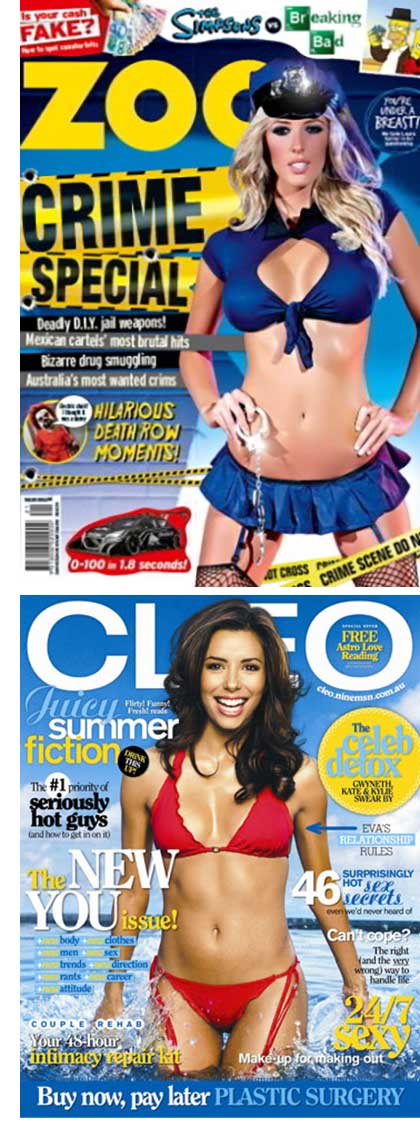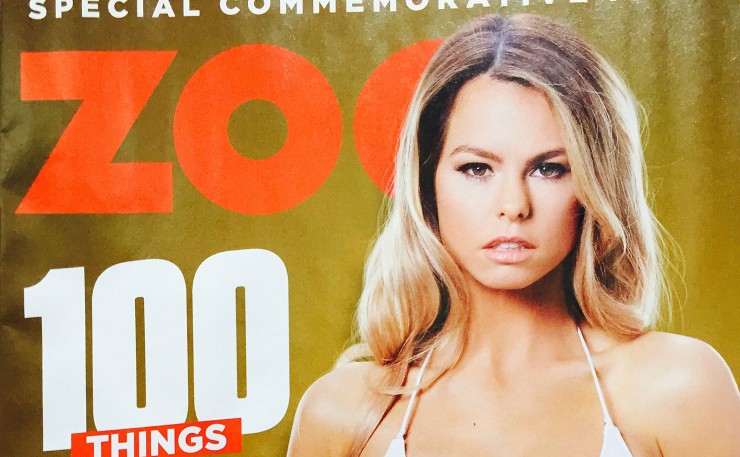News of the October closure of Zoo Weekly magazine will cheer anyone who values equality and dignity. But Zoo’s publisher, Bauer Media, continues to profit from sexually objectifying girls and women. As so do our major supermarkets.
Zoo famously photoshopped Senator Sarah Hanson-Young’s head onto a lingerie model. It ran competitions to “win a boob job for your girlfriend”, and it advised men to coerce girls into having sex: “You want to pick the ‘loosest/skankiest’ one of the lot and fetch her a drink… separate her from the flock.”
Targetted towards adolescents, these stunts worked. According to Bauer, boys aged 14-17 account for around 12,000 of Zoo’s readership (some reports claim this figure has been as high as 38,000).
These boys received relentless images of surgery-augmented young women alongside such messages as: “Women just really want to get f—ed”.
When activist group Collective Shout petitioned to remove the magazine from supermarkets, it contended that Zoo “normalised harmful attitudes towards women and has no place in supermarkets”.
But Bauer executive Ewan Page praised its editors for doing “a great job… I commend their work.”
When Coles removed the magazine from its shelves last month, Coles employee ‘Shannen’ reportedly said: “Other young women in my work force will no longer have to put up with selling a magazine that promotes rape culture.”

But Woolworths refused to divest. Perhaps it didn’t want to rankle a company that publishes almost every other magazine on its shelves.
Bauer’s Australian brands include The Australian Women’s Weekly, NW, Take 5, TV Week, OK!, Woman’s Day, Dolly, Elle Australia, Australian Gourmet Traveller, Australian Geographic, Harper’s Bazaar, Real Living, and Australian House & Garden.
With an annual turnover of $2.6 billion, Bauer has been accused of publishing pro-Nazi magazines. It also publishes Cleo and Cosmopolitan, magazines that aid and abet the culture promoted by Zoo.
Their articles typically champion equality, liberation, diversity and healthy relationships, but much content and the images that accompany it push an incompatible message: that a woman’s primary value lies in the way she’s packaged for others’ appraisal.
This packaging is oppressive and conformist. It is censorship. Not only does it censor out the majority of body types, it erases real choices that don’t align with profit agendas.
Melbourne University scholar Kate Farhall reports that around 65 per cent of Cleo content in 2013 was “dedicated to beauty, fashion, celebrity and advertising” compared with 13 per cent 40 years ago.
In Freedom Fallacy: The Limits of Liberal Feminism (2015), Farhall also documents the ways women’s magazine content now “centres on how to obtain and maintain a male partner, subordinating women’s needs and desires to men’s pleasure”.
Indeed, recent Cleo and Cosmo articles include “Guys pay to sleep with a hologram of me”; “‘Hot’ moves he doesn’t rate”; “Judge Judy is great in bed, says her husband”; “What does your boyfriend REALLY think of your fanny farts”; “Paralysed woman models lingerie”; and “I hate my small breasts — and that’s OK.”
Just as there’s little profit to be made from people feeling good about their appearance, there’s a profound difference between commercial sexualisation and authentic sexuality.
One generates sales, the other generates wellbeing. One objectifies; the other humanises.
Sexualisation, against which girls habitually measure their behaviour and self-worth, is a far cry from a healthy, unmediated, self-determined sexuality that nurtures positive feelings, intimacy and a sense of agency.
Commentators such as Catherine Lumby contend that boys who consume female sexualisation don’t necessarily have “boofhead views in reality”. But its damaging impacts on girls are well-documented.
Farhall, whose PhD focuses on sexuality in popular media, cites studies that find women and girls exposed to objectification “begin to self-objectify, dissociating from their bodies and instead viewing themselves as objects to be used and appraised by others”.
For many, this leads to “anxiety, shame and self-consciousness, as well as the disruption of mental functioning and inhibition of concentration.”
A broad body of studies link media objectification with eating disorders, body shame, low self-esteem, anxiety, low cognitive function, sexual dysfunction and depression. And a 2014 UN study finds that violence against women occurs in those countries with cultures of inequality. These magazines promote such cultures.
Given that this is a well-researched health issue, there should be mandatory warnings — similar to those on cigarettes — on magazines that promote women as ornaments and sexual objects.
After all, as they profit from such practices, enterprises like Bauer and its supermarket outlets actively create and maintain public health problems that are ultimately paid for by all — not just by those who consume its magazines.
While their sexism may not seem as explicit as that of the ill-fated Zoo, many media outlets and retailers are complicit in normalising women’s oppression, and are contributing to public health problems.
Donate To New Matilda
New Matilda is a small, independent media outlet. We survive through reader contributions, and never losing a lawsuit. If you got something from this article, giving something back helps us to continue speaking truth to power. Every little bit counts.




